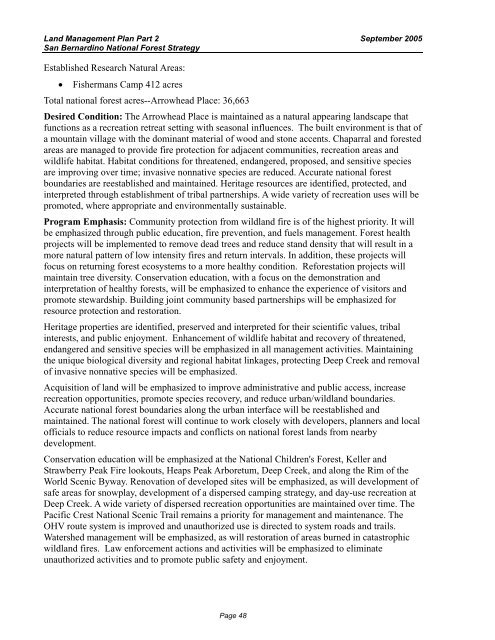San Bernardino National Forest Land Management Plan - Part 2
San Bernardino National Forest Land Management Plan - Part 2
San Bernardino National Forest Land Management Plan - Part 2
Create successful ePaper yourself
Turn your PDF publications into a flip-book with our unique Google optimized e-Paper software.
<strong>Land</strong> <strong>Management</strong> <strong>Plan</strong> <strong>Part</strong> 2<br />
<strong>San</strong> <strong>Bernardino</strong> <strong>National</strong> <strong>Forest</strong> Strategy<br />
Established Research Natural Areas:<br />
• Fishermans Camp 412 acres<br />
Total national forest acres--Arrowhead Place: 36,663<br />
September 2005<br />
Desired Condition: The Arrowhead Place is maintained as a natural appearing landscape that<br />
functions as a recreation retreat setting with seasonal influences. The built environment is that of<br />
a mountain village with the dominant material of wood and stone accents. Chaparral and forested<br />
areas are managed to provide fire protection for adjacent communities, recreation areas and<br />
wildlife habitat. Habitat conditions for threatened, endangered, proposed, and sensitive species<br />
are improving over time; invasive nonnative species are reduced. Accurate national forest<br />
boundaries are reestablished and maintained. Heritage resources are identified, protected, and<br />
interpreted through establishment of tribal partnerships. A wide variety of recreation uses will be<br />
promoted, where appropriate and environmentally sustainable.<br />
Program Emphasis: Community protection from wildland fire is of the highest priority. It will<br />
be emphasized through public education, fire prevention, and fuels management. <strong>Forest</strong> health<br />
projects will be implemented to remove dead trees and reduce stand density that will result in a<br />
more natural pattern of low intensity fires and return intervals. In addition, these projects will<br />
focus on returning forest ecosystems to a more healthy condition. Reforestation projects will<br />
maintain tree diversity. Conservation education, with a focus on the demonstration and<br />
interpretation of healthy forests, will be emphasized to enhance the experience of visitors and<br />
promote stewardship. Building joint community based partnerships will be emphasized for<br />
resource protection and restoration.<br />
Heritage properties are identified, preserved and interpreted for their scientific values, tribal<br />
interests, and public enjoyment. Enhancement of wildlife habitat and recovery of threatened,<br />
endangered and sensitive species will be emphasized in all management activities. Maintaining<br />
the unique biological diversity and regional habitat linkages, protecting Deep Creek and removal<br />
of invasive nonnative species will be emphasized.<br />
Acquisition of land will be emphasized to improve administrative and public access, increase<br />
recreation opportunities, promote species recovery, and reduce urban/wildland boundaries.<br />
Accurate national forest boundaries along the urban interface will be reestablished and<br />
maintained. The national forest will continue to work closely with developers, planners and local<br />
officials to reduce resource impacts and conflicts on national forest lands from nearby<br />
development.<br />
Conservation education will be emphasized at the <strong>National</strong> Children's <strong>Forest</strong>, Keller and<br />
Strawberry Peak Fire lookouts, Heaps Peak Arboretum, Deep Creek, and along the Rim of the<br />
World Scenic Byway. Renovation of developed sites will be emphasized, as will development of<br />
safe areas for snowplay, development of a dispersed camping strategy, and day-use recreation at<br />
Deep Creek. A wide variety of dispersed recreation opportunities are maintained over time. The<br />
Pacific Crest <strong>National</strong> Scenic Trail remains a priority for management and maintenance. The<br />
OHV route system is improved and unauthorized use is directed to system roads and trails.<br />
Watershed management will be emphasized, as will restoration of areas burned in catastrophic<br />
wildland fires. Law enforcement actions and activities will be emphasized to eliminate<br />
unauthorized activities and to promote public safety and enjoyment.<br />
Page 48
















